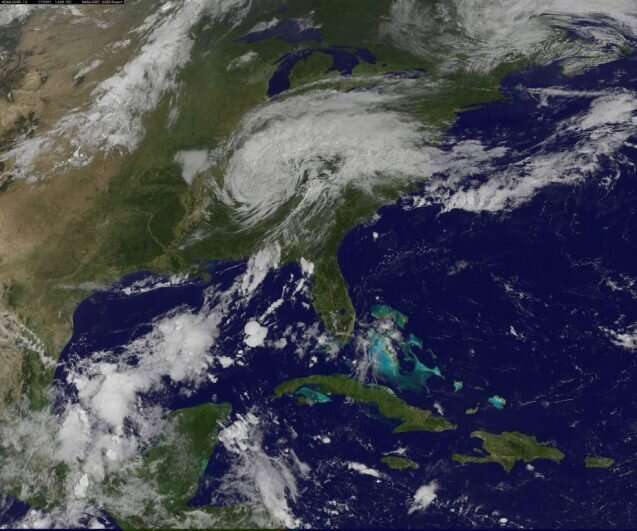Damaging rains from hurricanes can be more intense after winds subside

Howling wind drives torrential rain sideways as tall, slender palms bow and tree limbs snap. A hurricane approaches, its gale-force winds wreak havoc as it nears the coast. Storm surges combine with the downpour, inundating the area with water.
But according to new research, the rains that come once the storm has weakened may actually be more intense than when the storm is at its strongest.
"The highest intensities of rainfall occur after the hurricanes have weakened to tropical storms, not when they first make landfall as major hurricanes," said lead author Danielle Touma, a postdoctoral scholar at the University of California, Santa Barbara. The study appears in the journal Geophysical Research Letters.
Around the time Hurricane Harvey hit Houston in 2017, Touma was developing a new method for studying areas and intensities of rainfall around tropical cyclones—which include hurricanes and tropical storms—based on weather station data. Many previous studies have used satellite and radar data, but these records are limited to the late 20th and early 21st centuries. In contrast, records from weather stations begin in 1900. Using the measurements from the stations, Touma and her team could calculate the extent of land that experienced rain from a given weather system, as well as how much rain fell.
These issues came into in sharp focus during the 2017 hurricane season, especially as flooding in southern Texas racked up roughly $130 billion in damages, according to the National Oceanic and Atmospheric Administration.
Analyzing decades of records, the researchers discovered that the accompanying rainfall tended to be more severe after a hurricane had abated to the category of a tropical storm. In that sense, the cyclones were more dangerous after they had subsided, in spite of their slower wind speeds.
Tropical cyclones tend to slow down once they hit land because they are cut off from their energy source, the ocean. There is no longer warm water evaporating below them to drive the convection that fuels the system. As a result, the cyclone becomes disorganized and spins at lower speeds, causing it to spread out.
Naturally, this effect is most pronounced for cyclones that started as major hurricanes. A smaller cyclone would follow the same pattern—hit land, slow down, and spread out—but it wouldn't contain the sheer volume of water to cause the same degree of damage.
The researchers analyzed only hurricanes that made landfall in the United States, said study coauthor Suzana Camargo, a storm expert at Columbia University's Lamont-Doherty Earth Observatory. She said they would now expand the analysis to cover typhoons that make landfall in countries adjoining the west Pacific or Indian oceans. "We are curious if the results we got here are dependent on the region," she said.
Scientists predict that the intensity of tropical cyclone rainfall will increase as global temperatures rise. In fact, the team has already begun to see this trend in their historical data.
More information: Danielle Touma et al. Variations in the Intensity and Spatial Extent of Tropical Cyclone Precipitation, Geophysical Research Letters (2019). DOI: 10.1029/2019GL083452
Journal information: Geophysical Research Letters
Provided by Columbia University





















